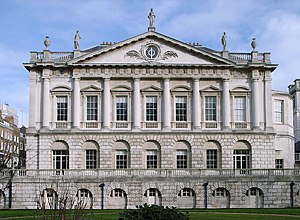
Back Townhouse (Storbritannien) Danish Casas adosadas en Gran Bretaña Spanish タウンハウス (イギリス) Japanese


In British usage, the term townhouse originally referred to the opulent town or city residence (in practice normally in Westminster near the seat of the monarch) of a member of the nobility or gentry, as opposed to their country seat, generally known as a country house or, colloquially, for the larger ones, stately home. The grandest of the London townhouses were stand-alone buildings, but many were terraced buildings.
British property developers and estate agents often market new buildings as townhouses, following the North American usage of the term, to aggrandise modest dwellings and to avoid the negative connotation of cheap terraced housing built in the Victorian era to accommodate workers. The aristocratic pedigree of terraced housing, for example as survives in St James's Square in Westminster, is widely forgotten. In concept, the aristocratic townhouse is comparable to the hôtel particulier, which notably housed the French nobleman in Paris, as well as to the urban domus of the nobiles of Ancient Rome.